Experimental Investigation into the Influence of LED Bias Setup on VLC Frequency Domain Characteristics: Beyond Non-Negativity
Abstract
1. Introduction
2. Theoretical Analysis
3. Experimental System
3.1. System Setup
3.2. Measuring Approach
3.2.1. LEDs to Be Measured
3.2.2. Measuring Range
3.2.3. Measuring Procedure
4. Experimental Results and Analysis
4.1. Experimental Results and Fitting Analysis
4.1.1. Error Function of Proposed Model
4.1.2. Polynomial Order Determination in Log-Domain
4.1.3. Proposed Log-Domain Linear Model and Fitting Error
5. Conclusions
Author Contributions
Funding
Institutional Review Board Statement
Informed Consent Statement
Data Availability Statement
Acknowledgments
Conflicts of Interest
Abbreviations
| VLC | Visible light communication. |
| LED | Light emitting diode. |
| NRV | Nonnegative real-valued. |
| BC | Bias component. |
| RF | Radio frequency. |
| DMT | Discrete multitone modulation. |
| CMOS | Complementary metal oxide semiconductor. |
| VNA | Vector network analyser. |
| PD | Photodiode |
Appendix A
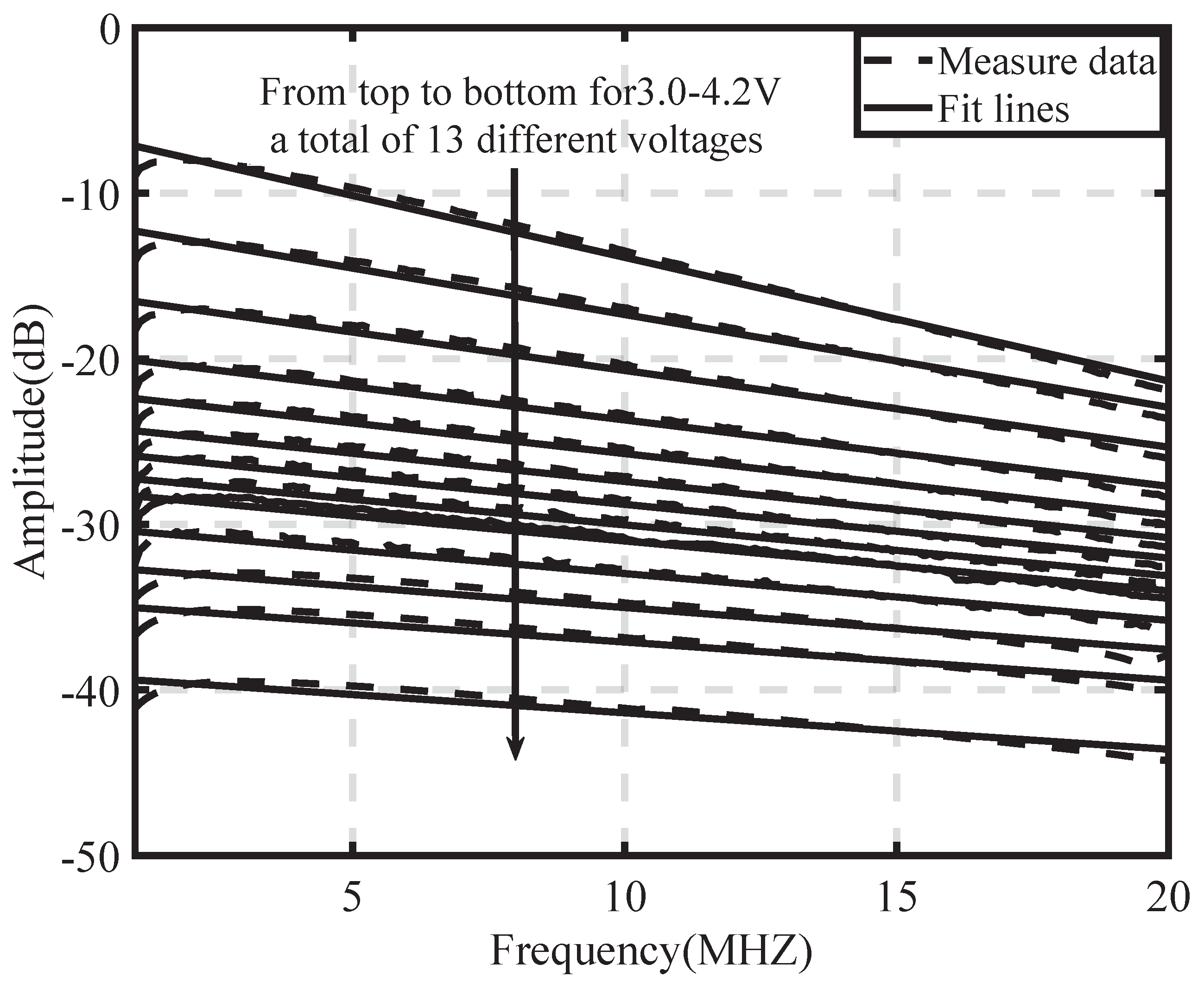
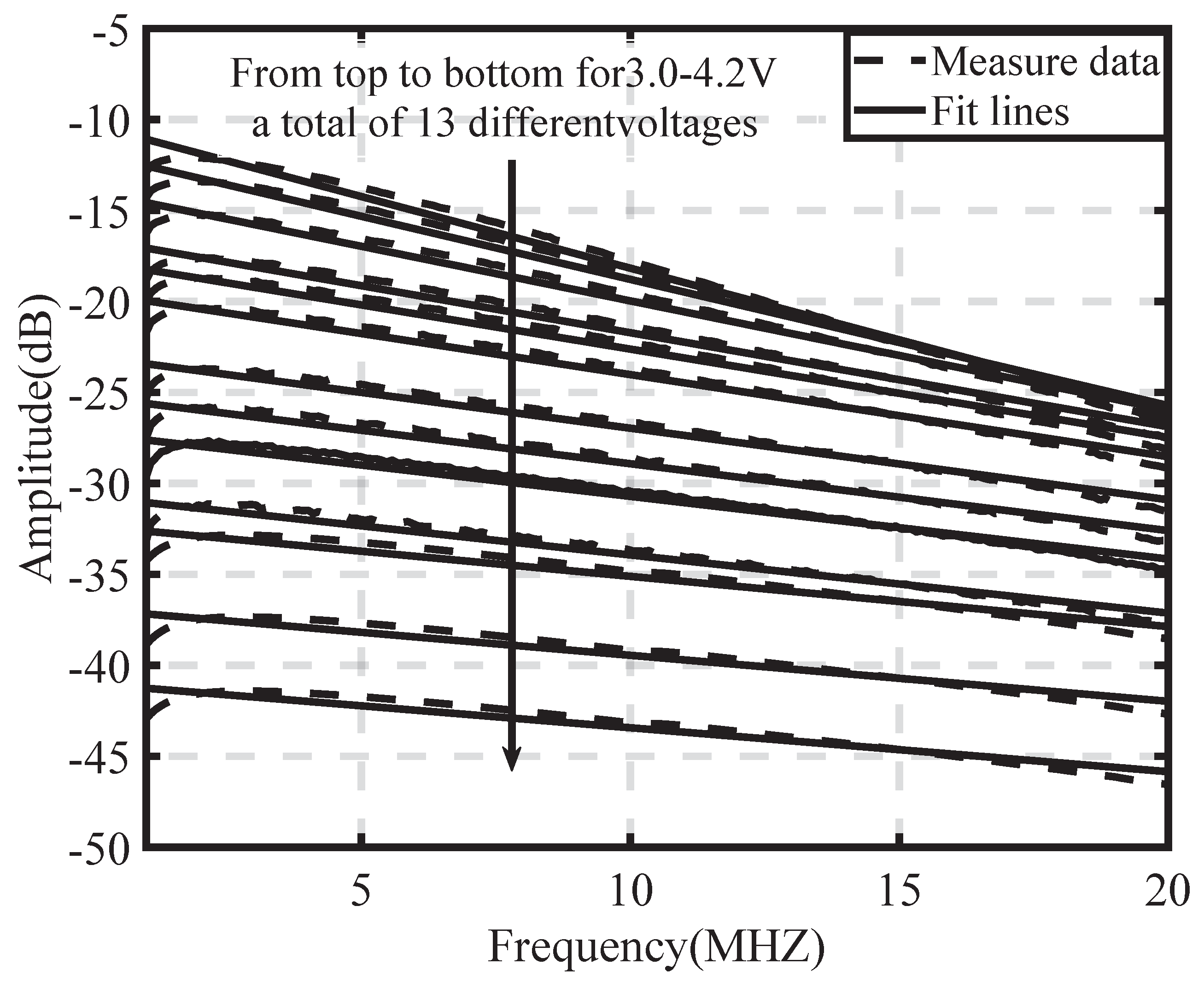
References
- Bao, X.; Yu, G.; Dai, J.; Zhu, X. Li-Fi: Light fidelity-a survey. Wireless Netw. 2015, 21, 1879–1889. [Google Scholar] [CrossRef]
- Langer, K.D.; Vučić, J.; Kottke, C.; Fernández, L.; Habe, K.; Paraskevopoulos, A.; Wendl, M.; Markov, V. Exploring the potentials of optical-wireless communication using white LEDs. In Proceedings of the 2011 13th International Conference on Transparent Optical Networks, Stockholm, Sweden, 26–30 June 2011; IEEE: Piscataway, NJ, USA, 2011; pp. 1–5. [Google Scholar]
- Grubor, J.; Lee, S.C.J.; Langer, K.D.; Koonen, T.; Walewski, J.W. Wireless high-speed data transmission with phosphorescent white-light LEDs. In Proceedings of the 33rd European Conference and Exhibition of Optical Communication-Post-Deadline Papers (Published 2008), Berlin, Germany, 16–20 September 2007; VDE: Frankfurt am Main, Germay, 2007; pp. 1–2. [Google Scholar]
- Le Minh, H.; O’Brien, D.; Faulkner, G.; Zeng, L.; Lee, K.; Jung, D.; Oh, Y. High-Speed Visible Light Communications Using Multiple-Resonant Equalization. IEEE Photonics Technol. Lett. 2008, 20, 1243–1245. [Google Scholar] [CrossRef]
- Le Minh, H.; O’Brien, D.; Faulkner, G.; Zeng, L.; Lee, K.; Jung, D.; Oh, Y.; Won, E.T. 100-Mb/s NRZ Visible Light Communications Using a Postequalized White LED. IEEE Photonics Technol. Lett. 2009, 21, 1063–1065. [Google Scholar] [CrossRef]
- Vučić, J.; Kottke, C.; Nerreter, S.; Langer, K.D.; Walewski, J.W. 513 Mbit/s visible light communications link based on DMT-modulation of a white LED. J. Light. Technol. 2010, 28, 3512–3518. [Google Scholar] [CrossRef]
- Khalid, A.M.; Cossu, G.; Corsini, R.; Choudhury, P.; Ciaramella, E. 1-Gb/s transmission over a phosphorescent white LED by using rate-adaptive discrete multitone modulation. IEEE Photonics J. 2012, 4, 1465–1473. [Google Scholar] [CrossRef]
- Azhar, A.H.; Tran, T.A.; O’Brien, D. Demonstration of high-speed data transmission using MIMO-OFDM visible light communications. In Proceedings of the 2010 IEEE Globecom Workshops, Miami, FL, USA, 6–10 December 2010; IEEE: Piscataway, NJ, USA, 2010; pp. 1052–1056. [Google Scholar]
- Zhao, C.; Li, W.; Yan, G.; Liu, Z. Application of Micro-LED in Visible Light Communication. In SID Symposium Digest of Technical Papers; Wiley: Hoboken, NJ, USA, 2020; Volume 51, pp. 117–120. [Google Scholar]
- McKendry, J.J.D.; Massoubre, D.; Zhang, S.; Rae, B.R.; Green, R.P.; Gu, E.; Henderson, R.K.; Kelly, A.E.; Dawson, M.D. Visible-light communications using a CMOS-controlled micro-light-emitting-diode array. J. Light. Technol. 2012, 30, 61–67. [Google Scholar] [CrossRef]
- Chun, H.; Manousiadis, P.; Rajbhandari, S.; Vithanage, D.A.; Faulkner, G.; Tsonev, D.; McKendry, J.J.D.; Videv, S.; Xie, E.; Gu, E.; et al. Visible Light Communication Using a Blue GaN μ LED and Fluorescent Polymer Color Converter. IEEE Photonics Technol. Lett. 2014, 26, 2035–2038. [Google Scholar] [CrossRef]
- Shatalov, M.; Chitnis, A.; Koudymov, A.; Zhang, J.; Adivarahan, V.; Simin, G.; Khan, M.A. Differential Carrier Lifetime in AlGaN Based Multiple Quantum Well Deep UV Light Emitting Diodes at 325 nm. Jpn. J. Appl. Phys. 2002, 41 Pt 2, L1146–L1148. [Google Scholar] [CrossRef]

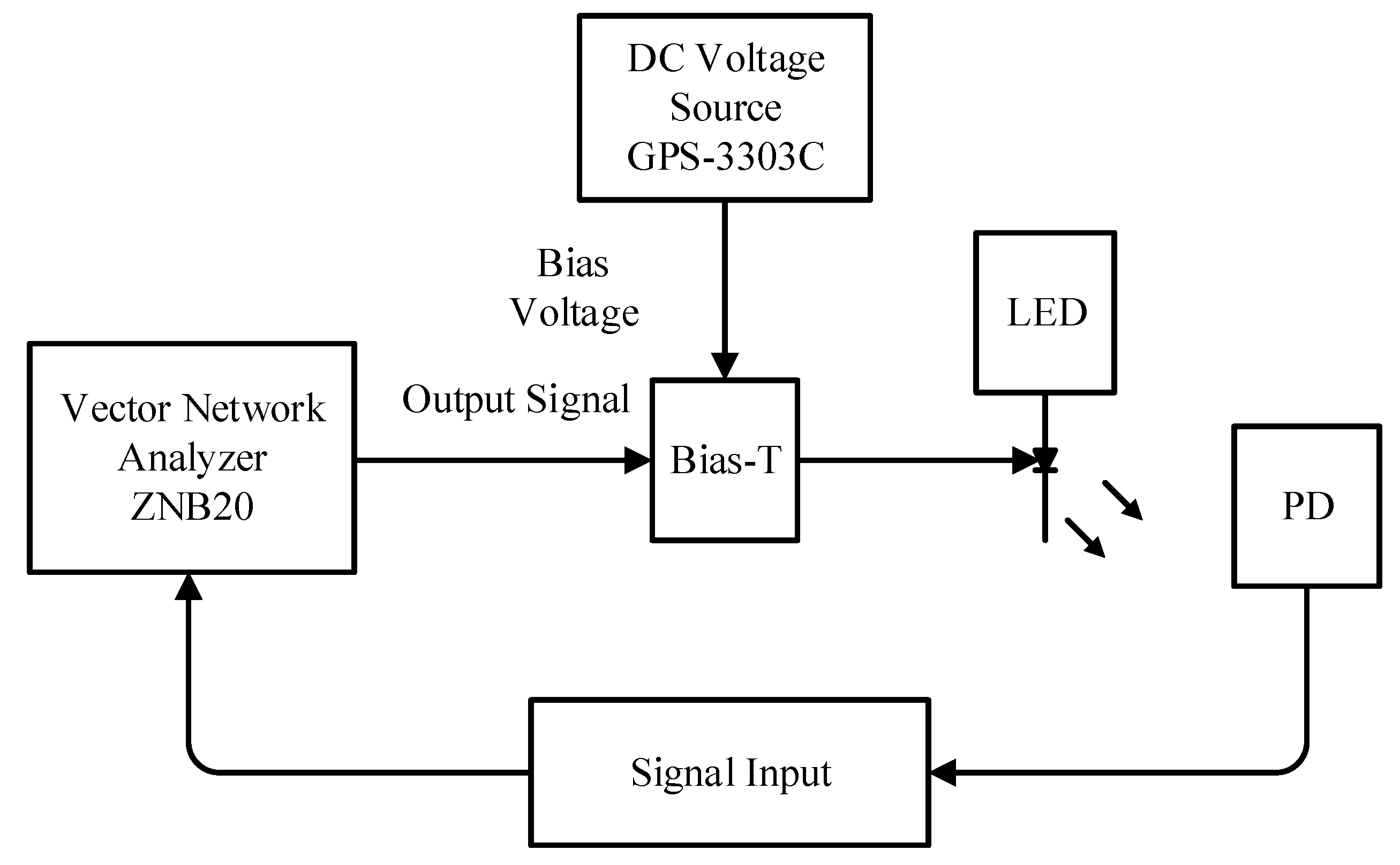
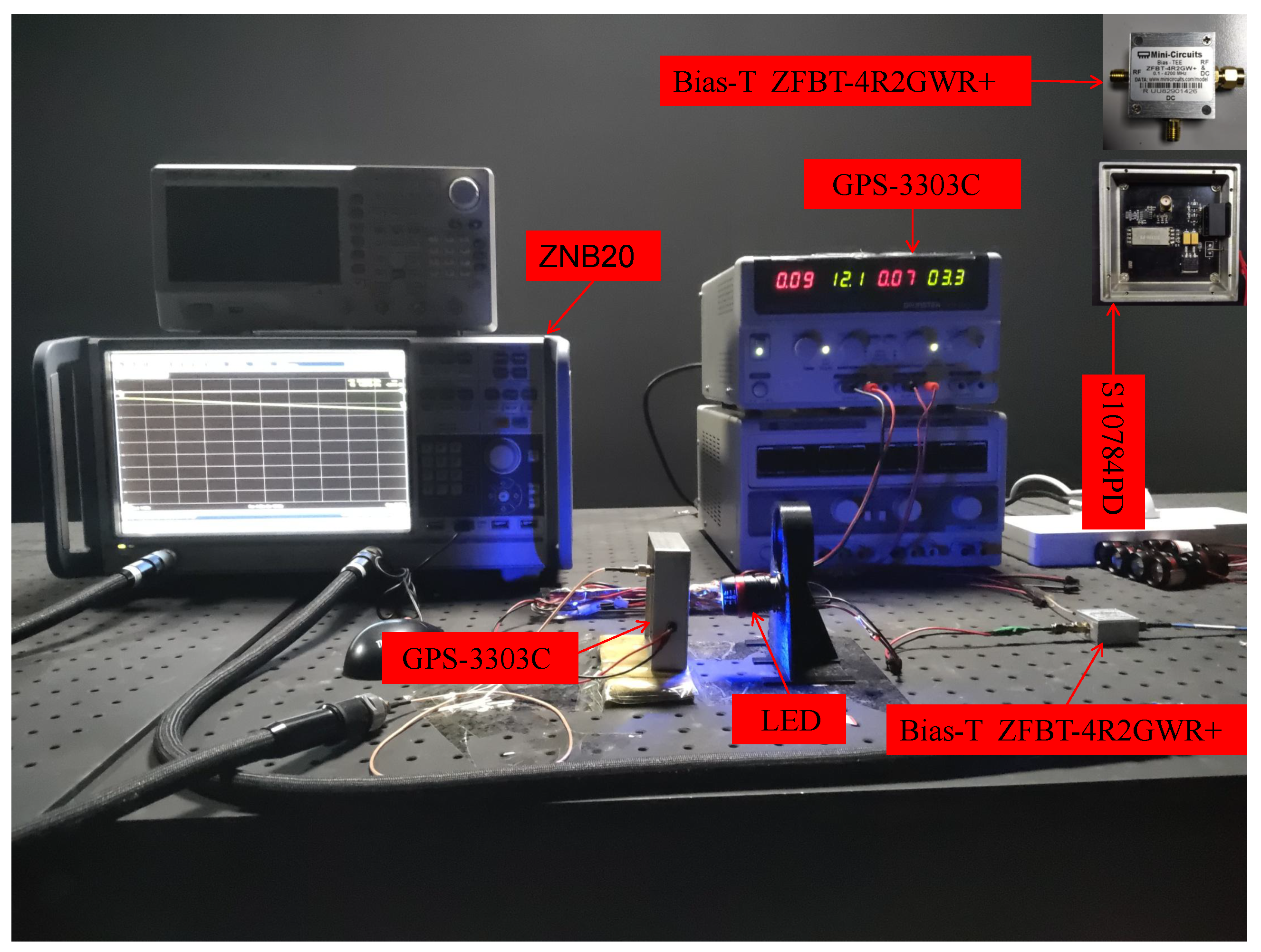
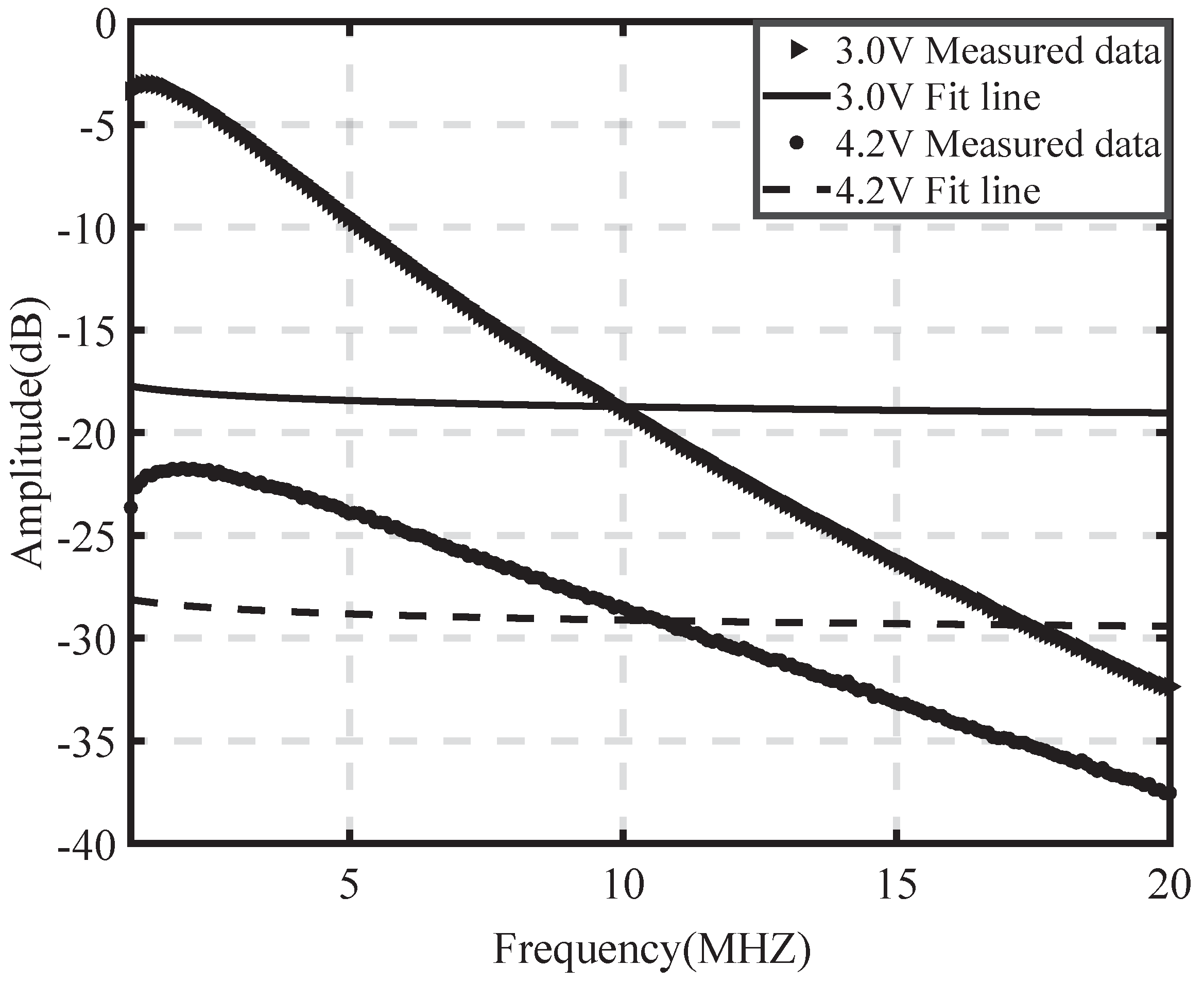
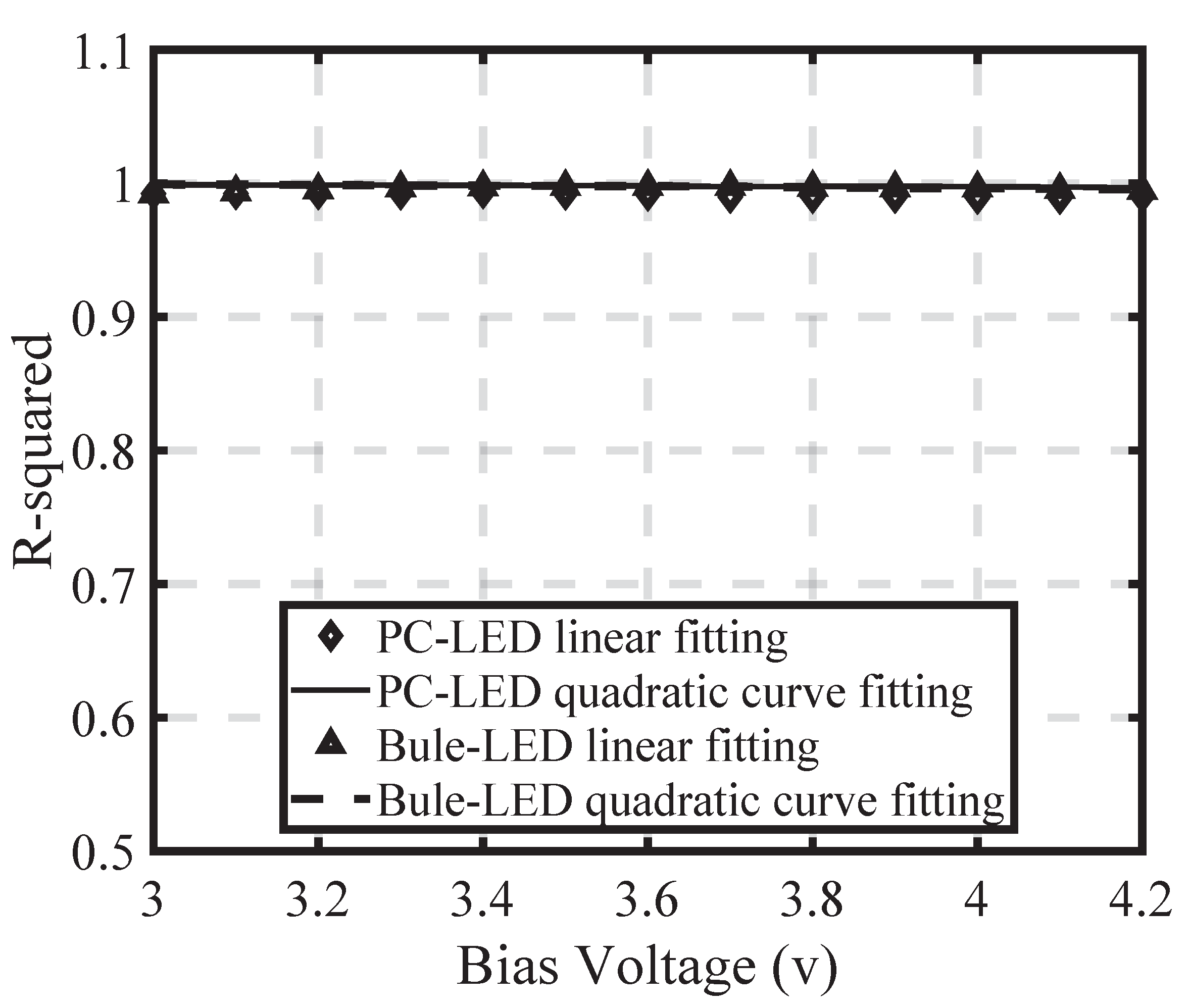
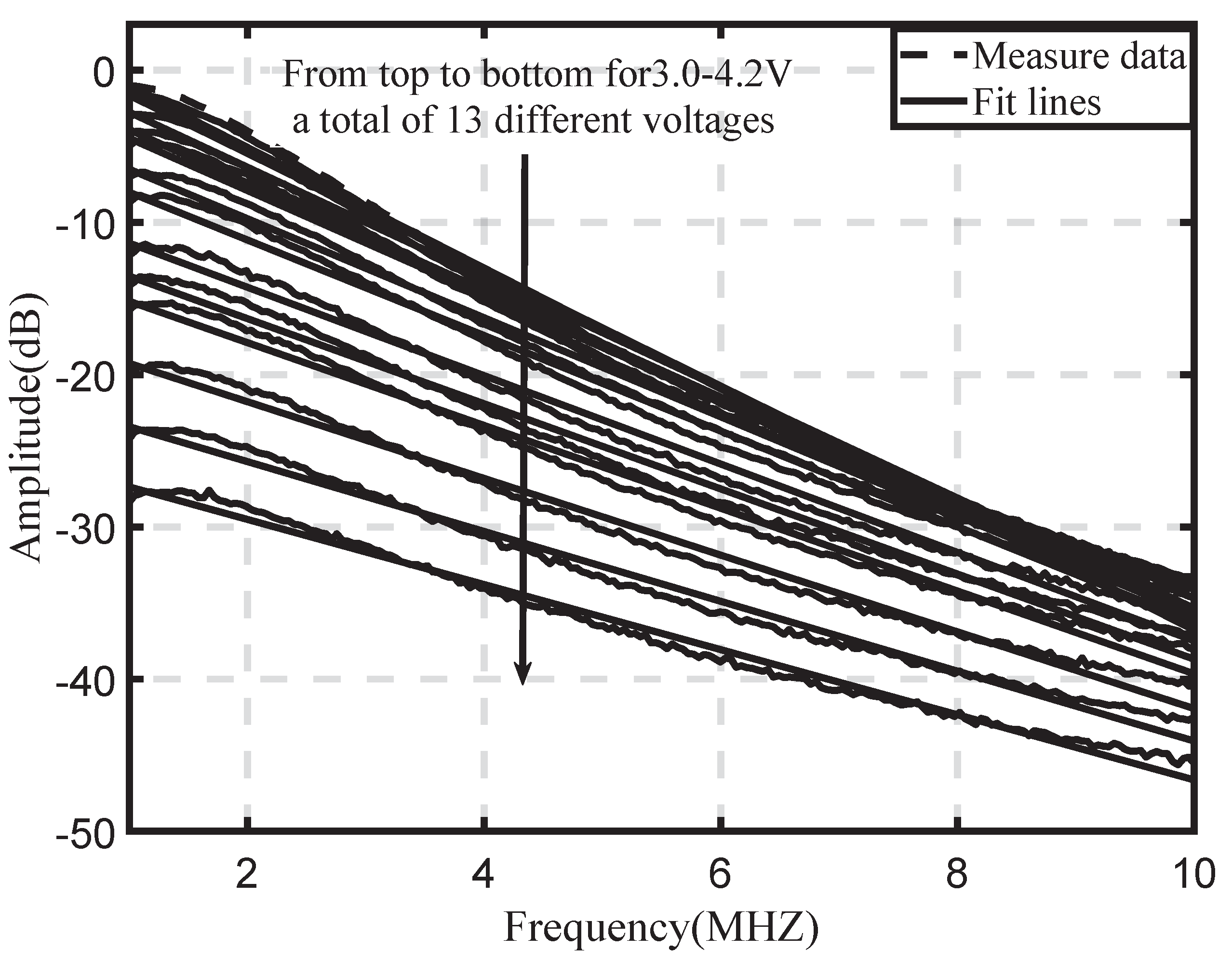
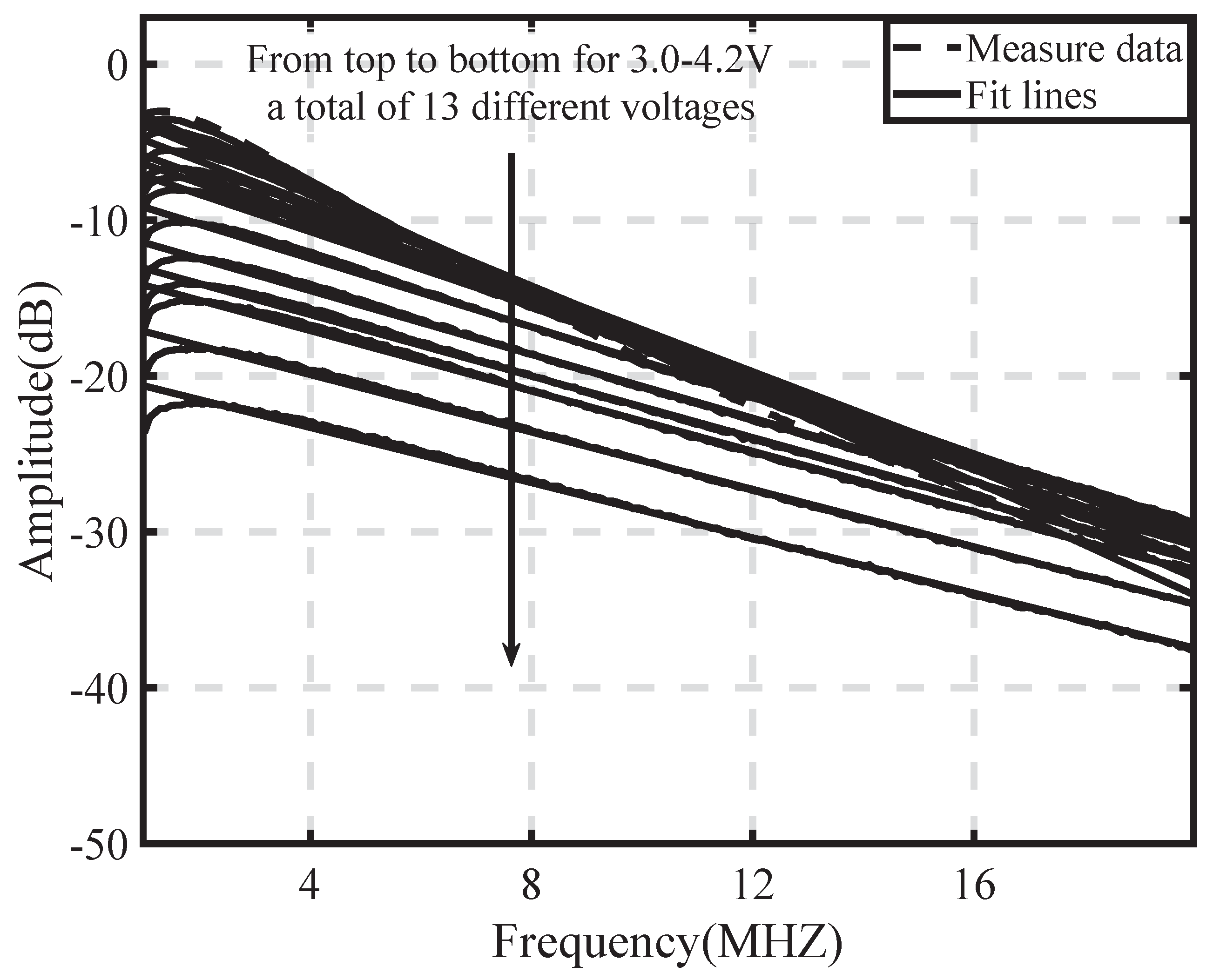
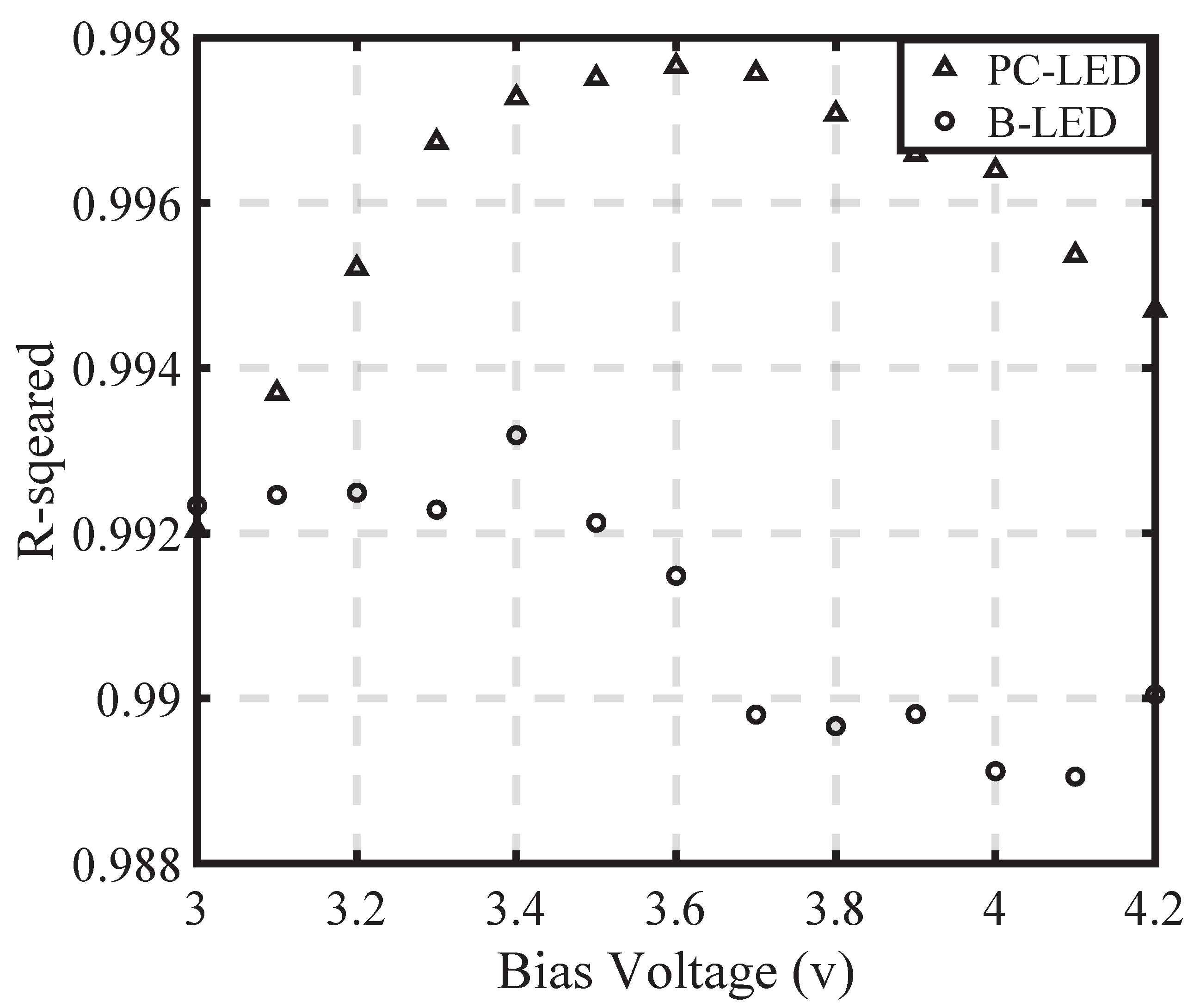
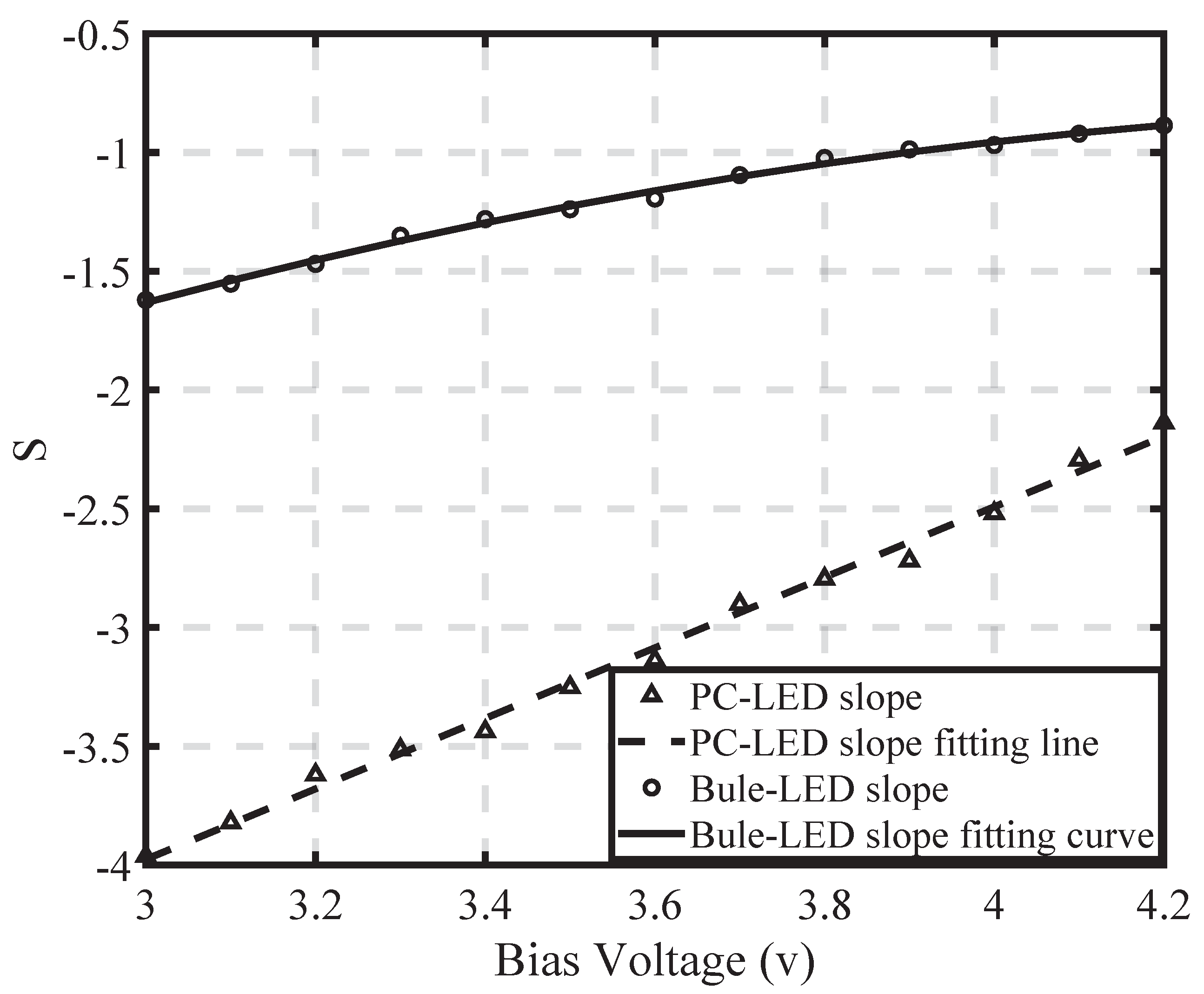
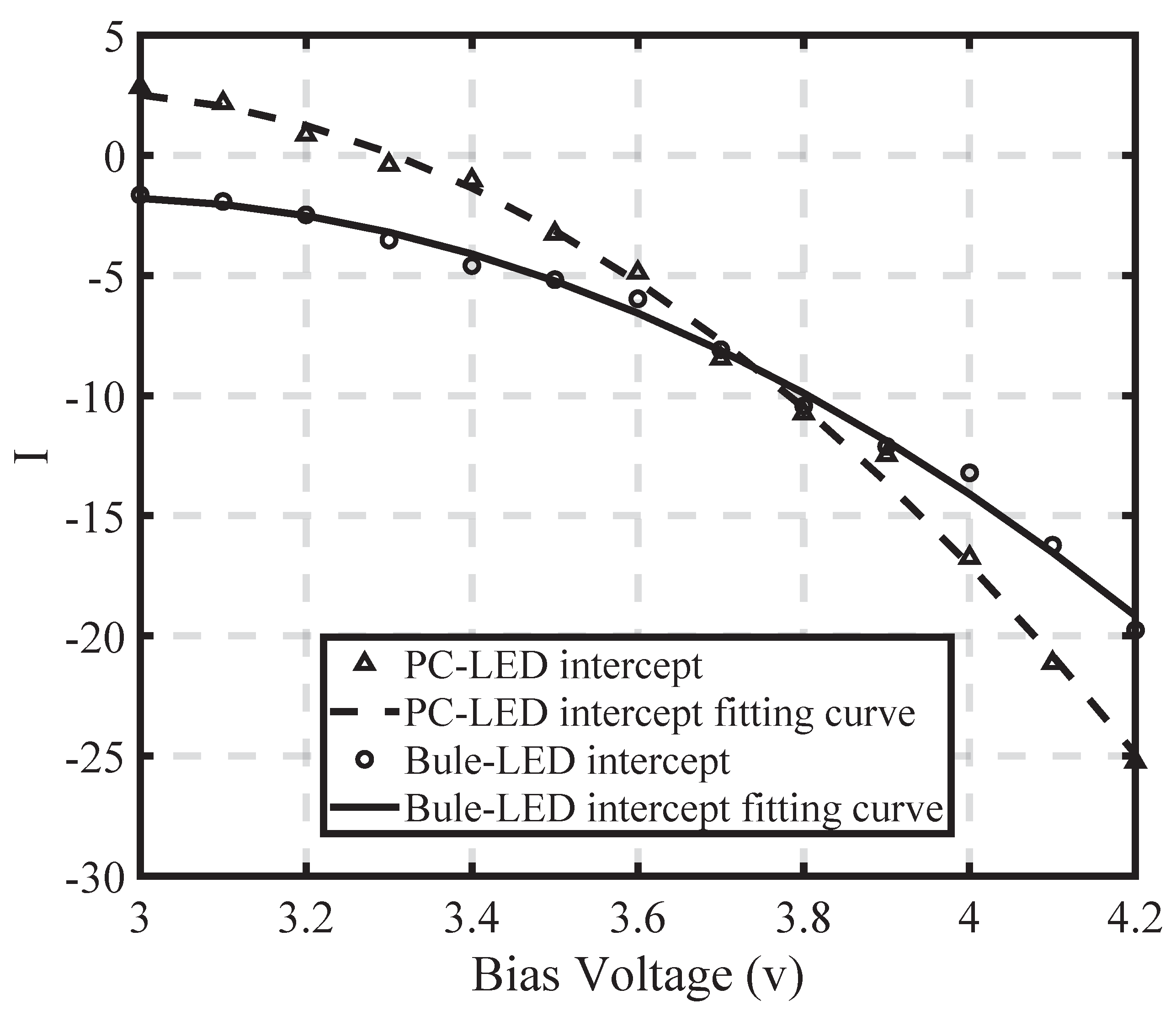
| Type of LED | Bias Voltage (V) | Linear Fitting Equation |
|---|---|---|
| PC-LED | 3.0 | |
| 3.1 | ||
| 3.2 | ||
| 3.3 | ||
| 3.4 | ||
| 3.5 | ||
| 3.6 | ||
| 3.7 | ||
| 3.8 | ||
| 3.9 | ||
| 4.0 | ||
| 4.1 | ||
| 4.2 |
| Type of LED | Bias Voltage (V) | Linear Fitting Equation |
|---|---|---|
| Bule-LED | 3.0 | |
| 3.1 | ||
| 3.2 | ||
| 3.3 | ||
| 3.4 | ||
| 3.5 | ||
| 3.6 | ||
| 3.7 | ||
| 3.8 | ||
| 3.9 | ||
| 4.0 | ||
| 4.1 | ||
| 4.2 |
Disclaimer/Publisher’s Note: The statements, opinions and data contained in all publications are solely those of the individual author(s) and contributor(s) and not of MDPI and/or the editor(s). MDPI and/or the editor(s) disclaim responsibility for any injury to people or property resulting from any ideas, methods, instructions or products referred to in the content. |
© 2023 by the authors. Licensee MDPI, Basel, Switzerland. This article is an open access article distributed under the terms and conditions of the Creative Commons Attribution (CC BY) license (https://creativecommons.org/licenses/by/4.0/).
Share and Cite
Li, L.; Zhang, Y.; Ba, B.; Yuan, T. Experimental Investigation into the Influence of LED Bias Setup on VLC Frequency Domain Characteristics: Beyond Non-Negativity. Photonics 2023, 10, 710. https://doi.org/10.3390/photonics10070710
Li L, Zhang Y, Ba B, Yuan T. Experimental Investigation into the Influence of LED Bias Setup on VLC Frequency Domain Characteristics: Beyond Non-Negativity. Photonics. 2023; 10(7):710. https://doi.org/10.3390/photonics10070710
Chicago/Turabian StyleLi, Long, Yanyu Zhang, Bin Ba, and Tao Yuan. 2023. "Experimental Investigation into the Influence of LED Bias Setup on VLC Frequency Domain Characteristics: Beyond Non-Negativity" Photonics 10, no. 7: 710. https://doi.org/10.3390/photonics10070710
APA StyleLi, L., Zhang, Y., Ba, B., & Yuan, T. (2023). Experimental Investigation into the Influence of LED Bias Setup on VLC Frequency Domain Characteristics: Beyond Non-Negativity. Photonics, 10(7), 710. https://doi.org/10.3390/photonics10070710





